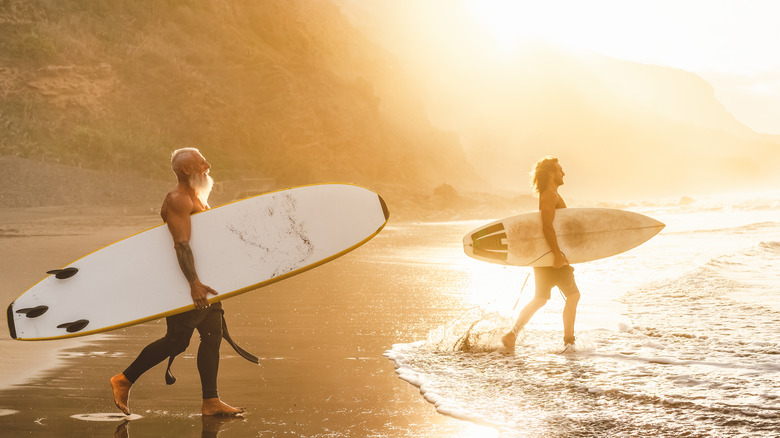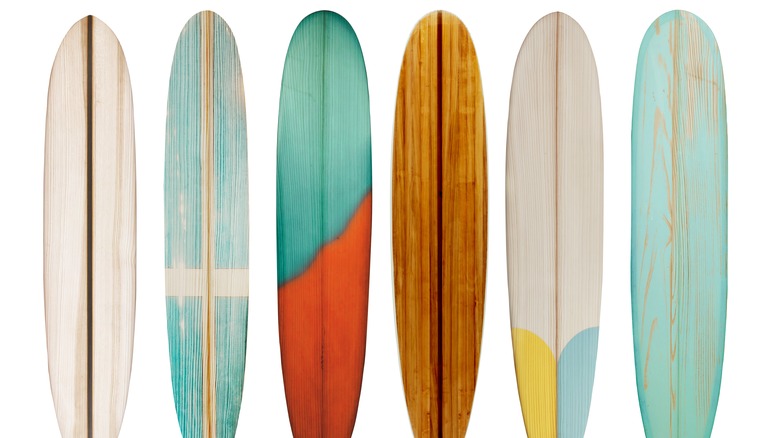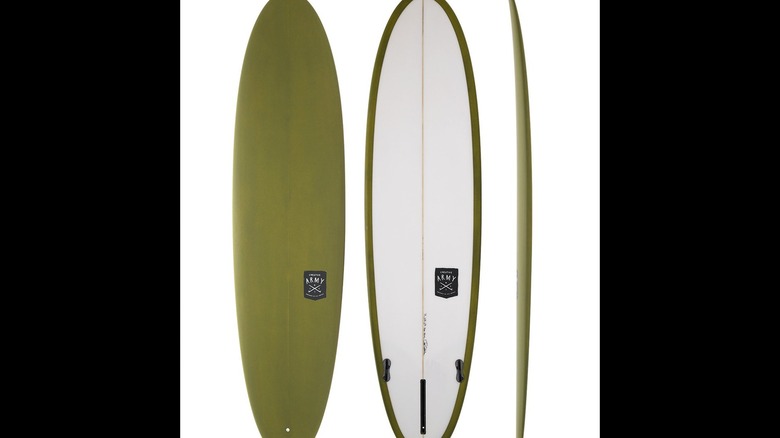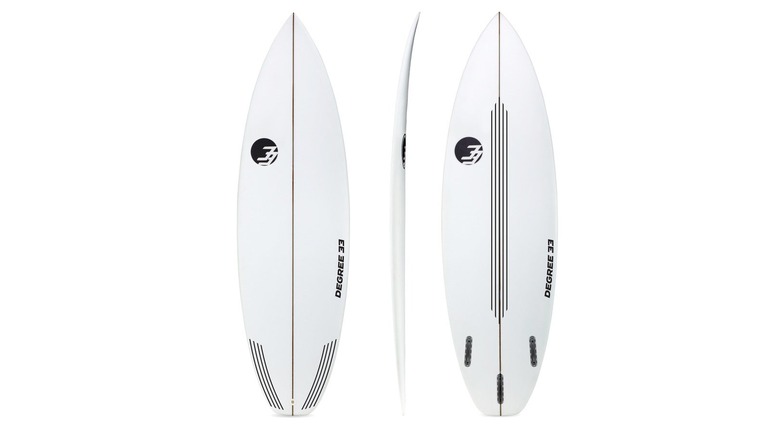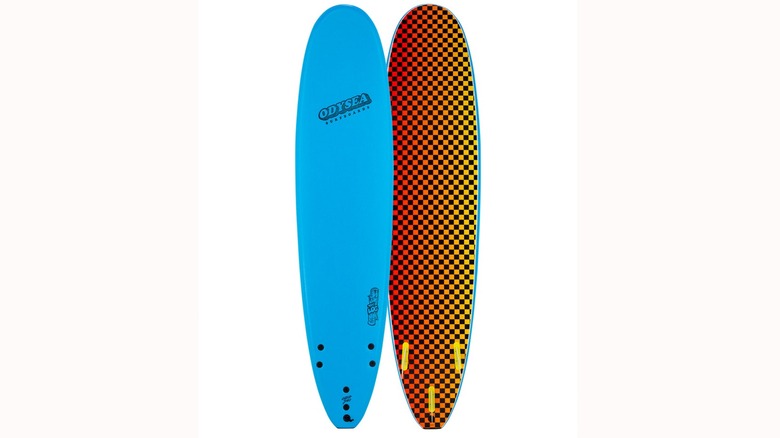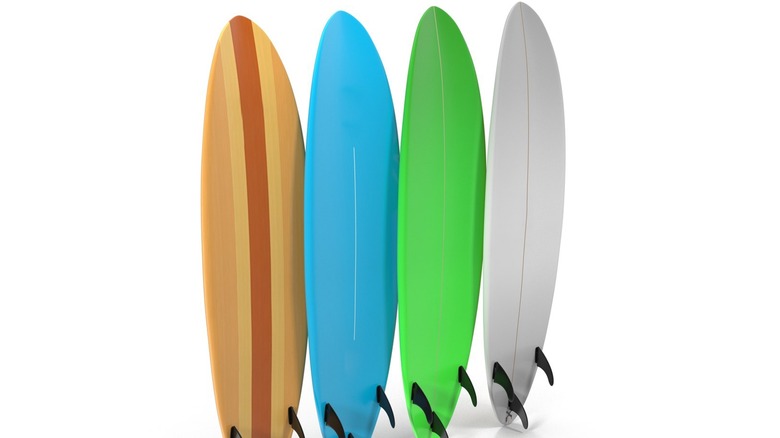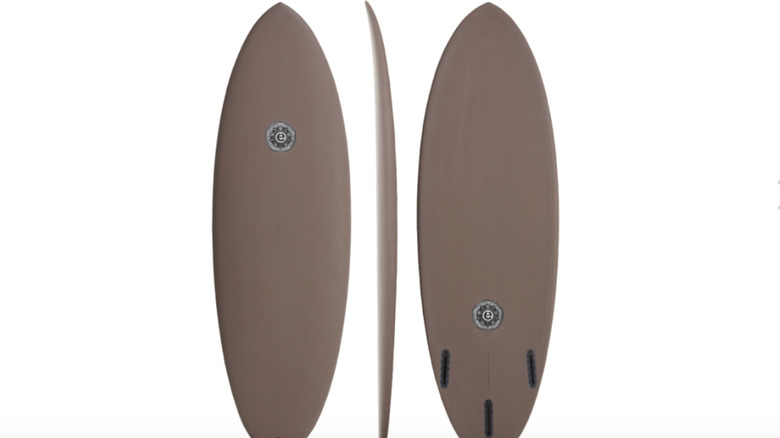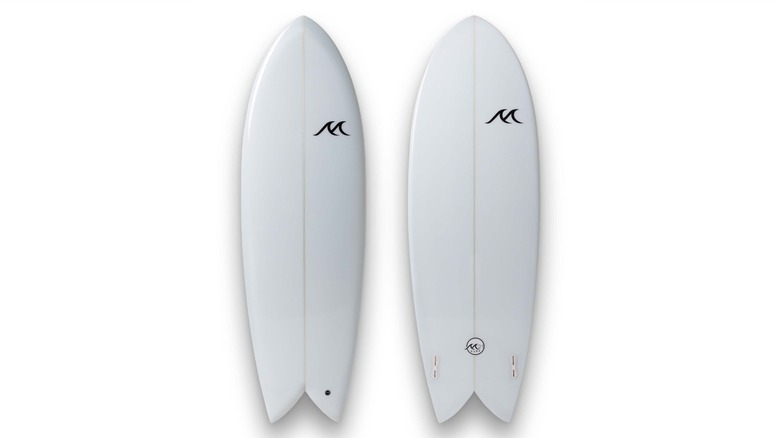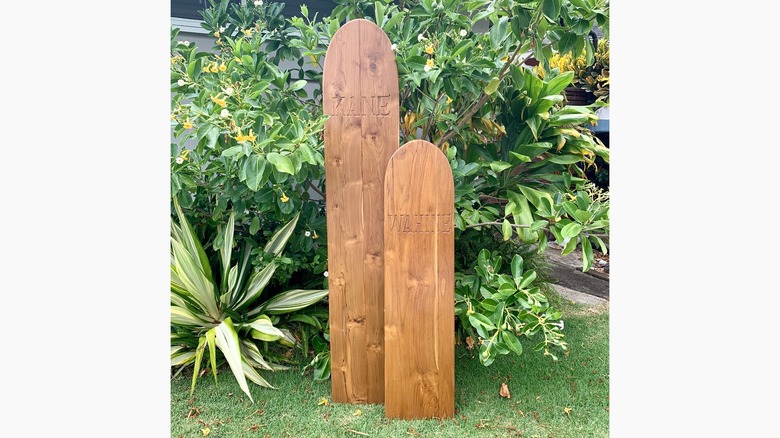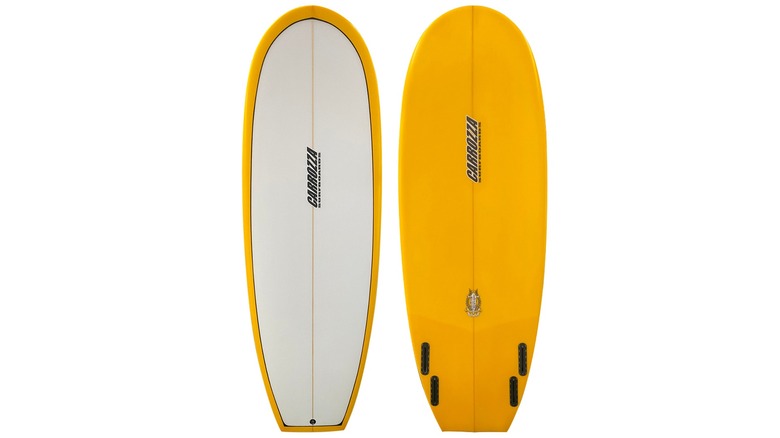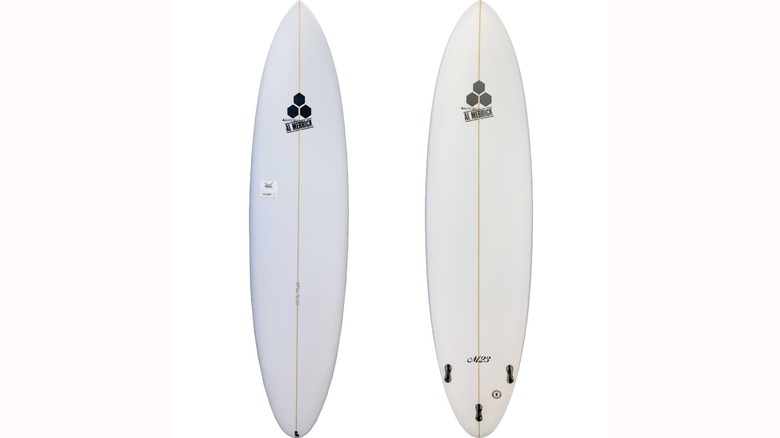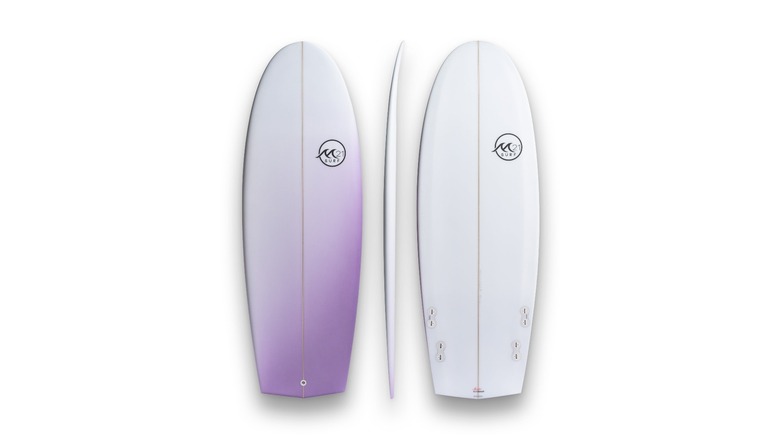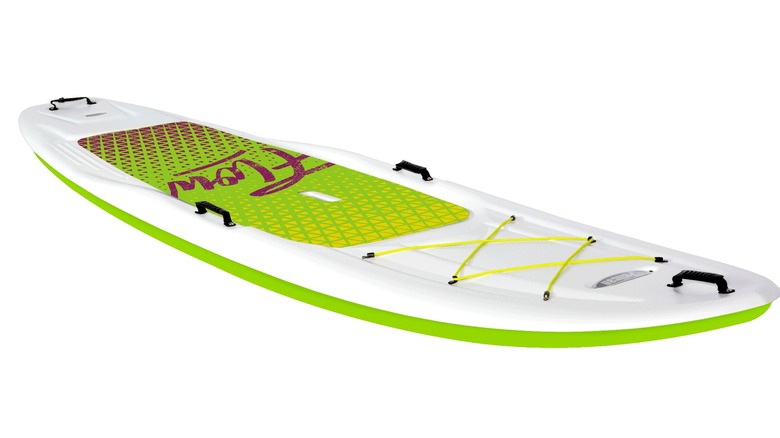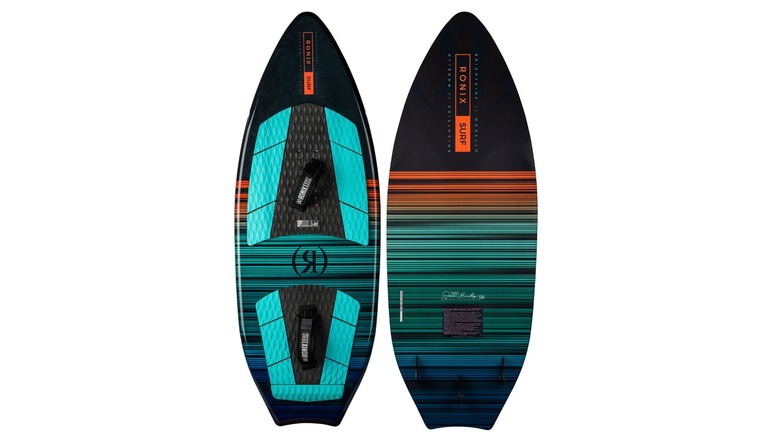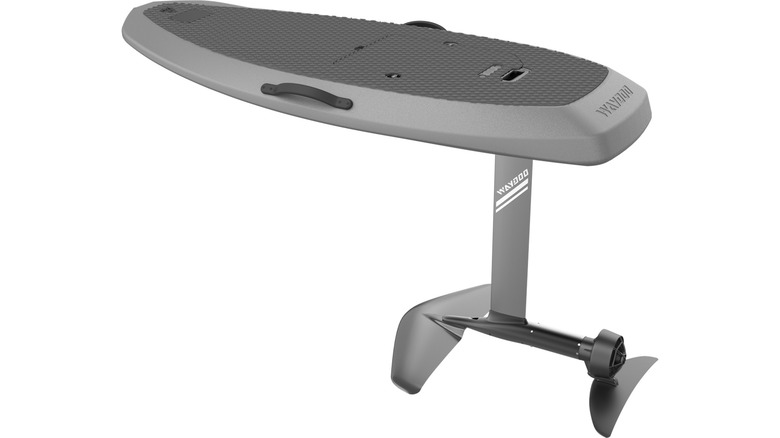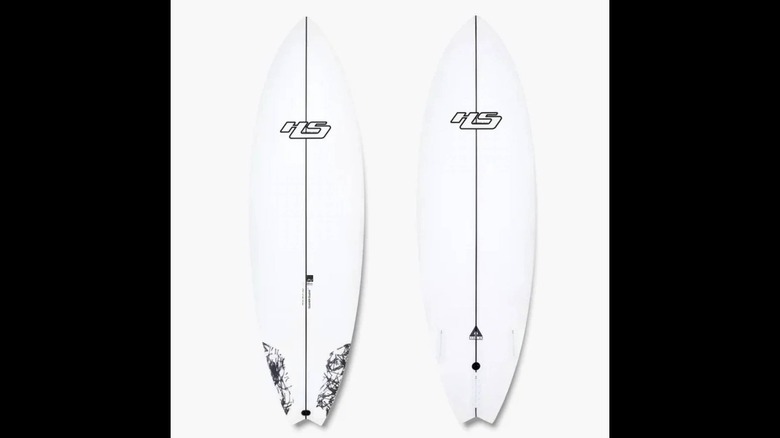15 Types Of Surfboards Explained
Surfing is a coastal pastime that dates back to the pre-colonization era of Hawaii. Now a popular sport in the United States and around the world, surfing has its own culture that's often romanticized in onscreen portrayals, giving birth to several surf-based shows and movies. But we wouldn't have any of this if it wasn't for the surfboard itself. In this article, we'll discuss the main types of surfboards that all surfers should be familiar with.
There are hundreds of ways to customize a board, more than an article of this scope can cover. In other words, there are more materials, fin options, board lengths and widths, shapes, custom options, and finishes than would be rational to discuss here. So, we're going to stick to the main design classifications to give you an overall idea of different surfboard types and how they're best used.
Longboards
Let's start with the classic: the longboard. When it comes to surfboards, this is the one most people can pick out of a lineup. The longboard has been featured in films and on television ever since surf culture became a mainstream phenomenon in the '50s and '60s. Thanks, Beach Boys. This board is the O.G. of the modern surfing world and, honestly, the most common design before modern manufacturing and materials sciences got on the scene. Not to be too obvious, but the longboard is the longest of the surfboards and can measure well over 10 feet in length.
Like each surfboard on this list, the longboard is surfed in its own unique fashion. To begin with, it's easier. That's an oversimplification, but the size of the board makes it more stable, as the amount of buoyant material makes staying above the waves easier, comparatively. Unfortunately, the larger boards also mean you can't carve waves or maneuver as easily. Shorter boards are better designed for that sort of thing, but at the end of the day, the longboard is probably the perfect beginner-friendly surfing option to help a novice get their "wave legs" under them.
Mid-length boards
As the name suggests, mid-length surfboards close the gap between longboards and shortboards. They typically range between 7.5 and 8.5 feet from nose to tail, and the standard mid-length board still has the tapered, torpedo-like shape you'd expect in a classic surfboard. And yes, you can probably find one with racing stripes or a puppy airbrushed onto it because they're about as common (though not the most common) as surfboards can be these days.
Riding a midrange board gives you a nice balance between stability and maneuverability, and even more so with certain customized options out there. These boards are fairly stable and allow surfers to ride different types and sizes of waves. They're not going to make the tricky stuff as easy as the shorter and specialty boards out there, but the trade-off is having a more stable base that keeps the board underneath you. Even experienced surfers will carve a mid-length.
Shortboards
We covered long and mid, so let's get down to shortboards. Shortboards are made for performance and maneuverability. This board, ranging from 5.5 to 6.5 feet in length, sacrifices buoyancy and stability for the ability to show off on the crushing side of a swell, which is probably why it's the most common board on the market. The shorter board allows experienced surfers to carve, cut back, grab air, and get barrelled, but they're not without drawbacks.
One of the cons of using a shortboard is the lack of material. This makes the surfboard less stable than other boards, which we've discussed, but it also means surfers have to paddle harder to chase a wave. This, of course, can equate to more missed waves. These boards also require more pumping than others to create speed because they don't move as fast as other boards shaped to glide.
Soft Tops
The majority of surfboards out there are hard tops, meaning they're made of rigid, firm material, such as different plastics, fiberglass, or epoxy. This is the standard. And while hard tops are faster in the water, they're not right for everyone who grabs a surfboard and heads for the waves. That's where soft tops come in.
Soft tops are another great board style for beginners because safety is the name of the game when you're a novice surfer. Opposed to the firm outer shell of hardtops, soft tops are often made with light foam cores that provide buoyancy and limit the weight that can come crashing down on you in a tumble.
However, they're slow, so these aren't the best boards for trying to shred the water and you'll have to work fairly hard to paddle. So, where hard tops stand the test of time and abuse better, soft tops are the right choice if you're just starting out or want to limit potential injury.
Funboards (or minimals)
Funboards, also known as "minimals," fall into the mid-length category. Now, there are several different types of mid-length boards, and we'll touch on a few specific varieties throughout this article that mostly come down to shape and purpose. As far as the funboard is concerned, these boards are designed for surfers early in the game to start branching out from gliding to really riding waves, with the added safety of a board made with materials that make it float well. They're not typically designed for large waves or surfing hollow, breaking waves (even though they have the tapered shape of a standard surfboard), but they do well in smaller and mid-range surf.
The main downside with funboards is that they aren't as easy to ride as longer boards, but that's fine. This board is more of a transitional option between a longboard or soft top and a performance shortboard anyway (unless you're a quick learner). If you're a more experienced surfer, you'll notice that funboards are difficult to dive under waves and they don't have the same swooping maneuverability as shortboards, but they serve their purpose.
Eggs
Another mid-length board, the egg surfboard gets its name from having a little extra in the middle, which flows to the nose and tail of the board, increasing the overall width. While the thicker midsections make them look more egg-shaped than other boards, you'll also have more surface area for your feet, which makes them more stable to stand on.
They're also higher in volume, which equates to better buoyancy in the water, but this higher volume offers a few added bonuses as well. It adds to the stability, for example, and increases the gliding speed of the board to reduce the effort it takes to paddle. Altogether, these attributes make the egg a good board choice for beginners, but beginners are not the only ones who'd benefit from this board.
The egg takes a little bit more skill than other beginner boards like a soft top or longboard. The nose can easily dive if you're not careful, the speed can potentially be overwhelming, and it can take a minute to find the proper weight distribution for balance.
Fish board
The fish board is a unique kind of shortboard. They're built much thicker and wider than other shortboards, often with a split tail, giving their riders more base to stand on and a more solid ride due to the buoyancy of increased volume. This makes the fish board great for larger surfers and a better choice of shortboards for novices. It also turns better than longboards and some of the other, larger beginner boards, so even the less experienced can learn to carve waves like the pros. Well, maybe not the pros, but you'll turn better than you would on a 10-foot surfboard.
While it's great for smaller waves, this board can be a little much in bigger surf. It's sometimes what's described as "loose," meaning it will turn out with less pressure than you'd think. This can be a good sign of the fish's movement capabilities or result in a bad day in the water, depending on how prepared you are. If you happen to be a beginner trying out a fish board, it's good to keep this in mind.
Alaias
One thing you'll notice when looking at surfboards is that generally come with fins. In fact, the fin shapes, numbers, configurations, and designs can get overwhelming. It almost feels like every board out there is doing something different when it comes to fins, and the alaia certainly is, but that's because it has no vertical fins at all.
Is there really anything to gain from these finless surfboards? Well, yes. As a matter of fact, there is, and that thing is grace. What alaias lack in paddle speed — and there's a good chance you'll be breathing heavily while chasing waves — they make up for in how well they ride breaking water.
They're smooth, can turn like nobody's business, and excel in small wave environments where other boards feel sluggish and boring. The popularity of these boards is pretty new. Although the boards' designs pay homage to traditional Hawaiian surfing, alaias bring something new to a sport that's been riding similar boards for decades.
Grovelers
It's not surprising to find so many shortboards on this list. They're the most popular boards in today's surfing world, especially among more experienced surfers. Where most shortboards are meant for tearing up big waves, you won't likely be using grovelers to shred the waves you see in movies or surfing competitions. They're just not designed for the massive waves coveted by aquatic adrenaline junkies. These boards are generally short, fat boards with almost no curve and, many times, a fat nose, which makes them perfect for moving about on small waves.
As has been mentioned several times in this article, the increased width of the board makes it float better because of the amount of buoyant material. They're fairly stable, as far as shortboards are concerned, but they also turn pretty darn well. Unfortunately, this board probably isn't the best thing for a beginner, but once you have a bit of intermediate surfing knowledge under your belt, the groveler will take your game to the next level.
Guns
Gun surfboards are one of the few that span all three major size categories for surfboards. They typically fall in the high mid-length category or the long category, with some exceeding 12 feet, but there are also mini-guns on the market for those surfers who prefer to stay in the shortboard world. The full-length guns are actually pretty rare since, as previously noted, shortboards are all the rage, but they're the original gun so we'll focus on them for now.
For a longboard, the gun lets you gain the paddle speed necessary to catch waves, and you won't want to miss these waves. This board is meant to ride some of the biggest and most dangerous waves in the world. They handle steep grades obnoxiously well, and their long, streamlined, and flat shape will help you glide as fast as possible. When it comes to control on massive swells, the gun is about as good as it gets, though it has drawbacks.
Diving a gun under the water takes a great deal of effort, and this isn't the board you'll want for everyday surfing. These bad boys are pretty much for big waves and big waves alone. If you're not surfing Mavericks or Nazare, you'll want something better suited to your needs.
Simmons
The Simmons design comes in both regular and mini Simmons. This board shape is responsible for making modern surfing the sport it is today by producing a board that could perform better than other boards of its time, which were basically flat. The Simmons introduced a curve (or "rocker" in surf lingo) that resembles a shallow sinusoidal wave pattern, allowing the board more maneuverability.
Movement and control are truly where this board excels. The rail, the edge of the surfboard, cuts into the water when you turn, and the slope, sharpness, and thickness of said rail help determine how well the board can turn in the water. With the Simmons, the rail is known as an "egg" rail, which slopes down on a nice curvature that lets you turn without working yourself to the bone. This board is also fast. It can keep up on large waves or speed across small waves all the same. Classic or modern, full-length or mini Simmons, these boards are a nice addition to a surfer's quiver.
SUPs
SUPs are a different way to enjoy the surf. Where surfing is reliant on riding waves, SUPs (or Stand Up Paddleboards) are used for more leisurely activities, but not always. For the most part, these boards are used for gliding across smooth water or light surf conditions, but some surfers have taken to surfing waves on a stand-up paddleboard. They even make special SUP designs with this purpose in mind. However, it's not necessarily recommended to drop into large waves with this type of board, especially if you aren't well-versed in both paddleboarding and surfing.
Several differences between paddleboards and surfboards make SUPs a totally different beast. First off, it's not a SUP if you aren't using a paddle, and the paddle will help propel you through the water. Second, paddleboards are typically either made primarily of a thick foam that's more buoyant than the average surfboard or made of plastic that's inflated when you reach the water. These boards also tend to have less curve, making them more difficult to use in turbulent water, and are designed to keep a rider afloat without the aid of movement. While these boards are notoriously stable in calm water, you can easily send your nose under when riding a wave if you don't know what you're doing.
Tow boards (or tow-in board)
Tow boards, also called tow-in surfboards, might be the next revolutionary thing in surfing. They're certainly changing the sport for anyone who may require a tow from a jet ski to hit the speeds required to catch huge waves. These boards resemble a traditional surfboard in some ways but would be easy to pick out of a lineup. To begin with, the telltale straps will give it away. Yes, these boards have deck straps for surfers to slide their feet into. They also tend to be quite small and shaped like torpedoes, which makes them capable of pulling off big stunts better than just about any board out there.
Between the small size of the board and the foot straps, tow-ins allow riders to turn their surfboard on a dime. No more trusting the edge to cut the wave perfectly. As long as you have the balance to keep the board underneath you, whipping a tow board around is a cakewalk. The shorter board also gives surfers more speed, which is essential in producing the momentum to maintain speed and carve waves. And really, these boards should be used by experienced surfers since bailing quickly can be a problem and they're only used on the heaviest waves on the planet.
Foil boards
If surfboards are the bicycles of the surfing world, then foil boards are the motorcycles. Or, more likely, the electric cars. Now, there are going to be some people who don't believe foil boarding counts as surfing, but since these boards are often sold at surf shops, handle the same way as a surfboard, and feel like you're surfing when you use them, we're going to roll with it.
What makes these boards unique? Well, the foil board is small because it's basically a platform to stand on. It's your turning mechanism that steers the foil as you lean and out, but the board itself has very little to do with your propulsion. Foil boards don't glide along the chaotic surf like surfboards, but rather are battery-powered and motor-driven behemoths that are capable of surfing even the calmest waters at high speeds by propelling themselves with the aid of a remote.
You'll spot foil board surfers pretty quickly out on the water since their board stands about a foot above the surface on a vertical pillar attached to their electric motor, but you'll also be jealous of how much fun they're having when the surf isn't producing.
Step up shortboards
Step up shortboards are, well, a step up from your standard shortboard. Honestly, there isn't much difference between step ups and shortboards. They're literally a few inches longer (not feet), but this adds to their speed and takes away from the effort needed to paddle into a drop.
At the end of the day, these boards are meant to be used when your normal surf is slightly heavier than what your standard equipment is designed for. That's when you step up your game (pun intended) and hop on the board with a couple extra inches that otherwise handles like a shortboard. Well, mostly anyway. They'll probably be a bit stiffer in the turn, but nothing you're really going to notice.
These boards weren't designed for massive waves, and you probably shouldn't try to force step ups to perform under those conditions. In other words, a step up board isn't designed to replace a gun. They'll still handle fairly large hollows though, so have fun out there.
